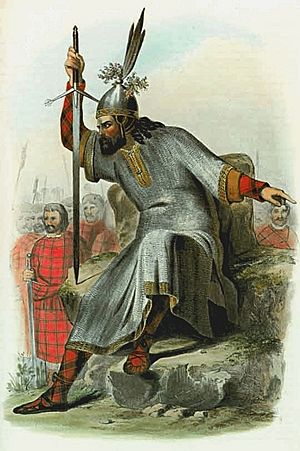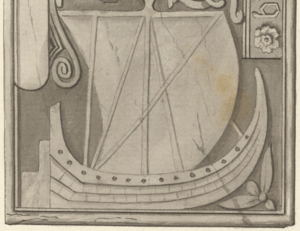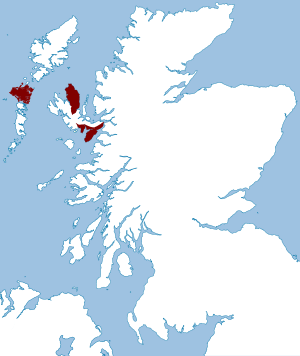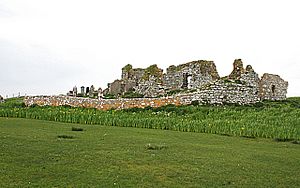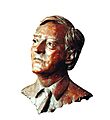Clan Macdonald of Sleat facts for kids
Quick facts for kids Clan Macdonald of SleatClann Ùisdein |
|||
|---|---|---|---|
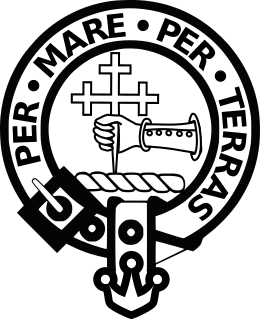 |
|||
| Motto | Per mare per terras (By sea and by land) | ||
| Profile | |||
| Region | Highland and Islands | ||
| District | Inverness-shire | ||
| Plant badge | Common heath | ||
| Chief | |||
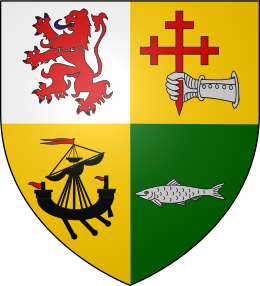 |
|||
| Sir Ian Godfrey Bosville Macdonald of Sleat | |||
| 17th Baronet of Sleat, 25th Chief of Macdonald of Sleat (Mac Ùisdein) | |||
| Seat | Thorpe Hall, Rudston, East Yorkshire, England | ||
| Historic seat | Dunscaith Castle; Duntulm Castle; Armadale Castle | ||
|
|||
|
|||
Clan Macdonald of Sleat, also known as Clan Donald North, is a large Scottish clan. In Gaelic, it's called Clann Ùisdein (which means "children of Ùisdean"). This clan is a branch of Clan Donald, one of Scotland's biggest clans.
The Macdonalds of Sleat were founded by Ùisdean, or Hugh. He was a great-great-great-great-grandson of Somerled, a powerful leader from the 1100s known as the Lord of the Isles. The clan and its chief are officially recognized by the Lord Lyon King of Arms, Scotland's expert on heraldry.
The Macdonalds of Sleat had many conflicts with other clans, especially the Macleods of Harris & Dunvegan and the Macleans of Duart. They also faced challenges from within their own clan in the early 1500s.
Later, the clan supported the King's side in the Wars of the Three Kingdoms (a big civil war). They also joined the Jacobite rebellion in 1715. However, they chose not to join the next Jacobite uprising in 1745. In the 1700s, the clan's chiefs moved to northern England and rarely visited their old lands. This led to hard times for many clan members. During the 1700s and 1800s, many people were forced off their lands in what became known as the Highland Clearances. Today, members and descendants of the clan live all over the world.
Contents
History of the Macdonalds of Sleat
Where the Clan Began
The Macdonalds of Sleat are part of Clan Donald, one of Scotland's largest clans. Clan Donald gets its name from Domhnall, who was the son of Raghnall, and grandson of Somerled. Somerled was a powerful leader in the 1100s.
The Macdonalds of Sleat are descendants of Domhnall's great-grandson, Ùisdean. Because of Ùisdean, the clan is also known in Gaelic as Clann Ùisdein ("the children of Ùisdein").
The 1400s: Early Days
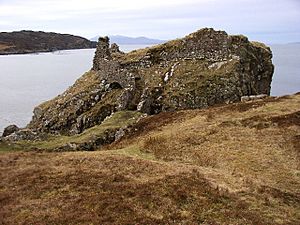
The first stories about Ùisdean say he went on a raiding trip to Orkney around 1460. He was successful and brought back many treasures. In 1469, Ùisdean received lands in South Uist, Benbecula, North Uist, and Sleat from the Earl of Ross.
The earliest home for Clann Ùisdein in Sleat was Dunscaith Castle. Ùisdean helped the king, and in return, he was promised more land. When the Lordship of the Isles was lost in 1493, Ùisdean got royal approval for his lands. He passed away in 1498.
Ùisdean had several children. His eldest son, Eoin, became the next chief. Other sons, like Dòmhnall Gallach and Dòmhnall Hearach, would play important roles later.
The Early 1500s: Challenges and Changes
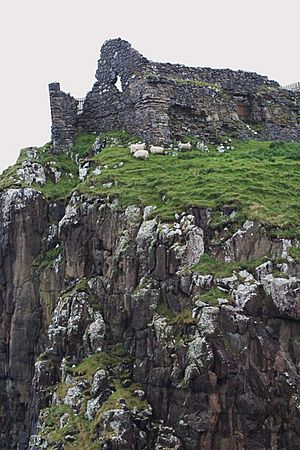
When Eoin became chief, he gave up some clan lands to the king. This meant other clans, like the Macdonalds of Clanranald and Clan MacLeod, received parts of these lands. This caused many problems later on.
After Eoin, Dòmhnall Gallach became chief. Even though some lands were legally given away, Dòmhnall Gallach and his brothers managed to keep control of their lands in Skye and Uist. Dòmhnall Gallach lived at Dunscaith Castle. Sadly, he was killed in 1506 by his brother, Gilleasbaig Dubh. There were many conflicts within the clan during this time, with different brothers fighting for power. This period was very unstable for Clann Ùisdein. Eventually, Dòmhnall Gruamach, Dòmhnall Gallach's son, became chief around 1515–1520.
Mid to Late 1500s: Alliances and Feuds
Dòmhnall Gruamach, the new chief, made agreements with other clans like Clan Campbell of Cawdor and Clan Mackintosh. In 1528, he worked with Macleod of Lewis to drive out the Macleods of Harris & Dunvegan from Trotternish. The government tried to stop these conflicts, but they continued. Dòmhnall Gruamach died around 1537.
His son, Dòmhnall Gorm, became chief but was killed in 1539. His young son, Dòmhnall Gormeson, then became chief, but his granduncle, Gilleasbaig Clèireach, led the clan because Dòmhnall Gormeson was a child. Dòmhnall Gormeson later submitted to the government and tried to keep peace. However, he was involved in raids against the Macleans in 1562. He died in 1585, and his son, Dòmhnall Gorm Mòr, became chief.
Late 1500s: More Conflicts
Dòmhnall Gorm Mòr was young when he became chief. The clan's lands were divided between his granduncle, Seumas of Castle Camus, and other family members. They often struggled to pay their taxes.
In 1585, Dòmhnall Gorm Mòr's men were attacked by the Macleans of Duart in Jura. This started a fierce conflict between the Macdonalds of Sleat and the Macleans. The fighting ended around 1589, and the chiefs were fined by the king.
In the 1590s, Dòmhnall Gorm Mòr led forces to Ulster to support Irish rebels against England. One large fleet of 50 galleys and 70 supply ships was attacked by English ships, and many Macdonald galleys were sunk.
Fights with Macleod of Harris & Dunvegan
A bitter feud started between Dòmhnall Gorm Mòr and the Macleod chief, Ruairidh Mòr. Dòmhnall Gorm Mòr had sent his wife, who was Ruairidh Mòr's sister, back to him in a way that insulted the Macleods. This led to attacks on each other's lands.
In one event, 40 Macleods took goods from a church in North Uist. They were then attacked by 15 Uistmen led by Dhòmhnall MacIain 'Ic Sheumais, and almost all the Macleods were killed. The fighting became very harsh, causing great hardship for the common people.
The Macdonalds of Sleat made a final big attack on the Macleods in Skye. This battle, called the Battle of Coire Na Creiche, was the last clan battle fought on the Isle of Skye. The Macleods were defeated. The government eventually stepped in to stop the fighting, and the two chiefs made peace around 1601.
The 1600s: Royal Support and Civil War

In 1608, many Macdonald chiefs, including the chief of Sleat, were called to a meeting with the King's representative. They were all imprisoned for not agreeing with the King's plans for the Isles. Donald, the chief of Sleat, was held in Blackness Castle until he agreed to the King's terms. He died in 1616, and his nephew, Sir Donald Macdonald, became the first Baronet of Sleat.
Mid-1600s: Civil War in Britain
In 1644, civil war broke out in Britain. Sir James Macdonald, the 2nd Baronet of Sleat, became chief. His lands had about 12,000 people, making him a powerful figure. He supported the King's side, though not always with great enthusiasm.
His men joined the King's army and fought in battles like Inverlochy and Battle of Auldearn. They also took part in the Battle of Preston in 1648, where many Highland men were defeated. After the King's defeat, the Sleat men returned home. Sir James made peace with the new government. He died in 1678, and his son, Donald, became the 3rd Baronet.
Late 1600s: Jacobite Rebellions
The 3rd Baronet, Donald, was often ill. In 1689, he joined the Jacobite cause to support King James VII. He led 500 men, but became ill and his son, also named Donald, led them at the Battle of Killiecrankie. The Sleat men fought bravely but suffered many losses.
After the rebellion failed, the government tried to make peace with the Macdonalds of Sleat. The chief was stubborn at first, and two warships were sent to Skye to shell his houses. Eventually, he made peace with the government. The 3rd Baronet died in 1695, and his son, Sir Donald Macdonald, 4th Baronet, became chief.
The 1700s: New Challenges
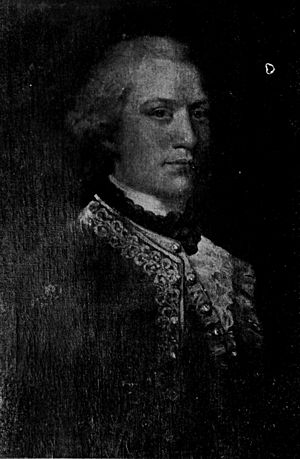
The 4th Baronet, Sir Donald, was a strong leader. He supported the Jacobite rebellion of 1715, leading 700 to 900 men. He became ill and returned to Skye, leaving his brothers in command. When government troops came to Skye, he fled to North Uist.
Because he didn't surrender in person, his lands were taken by the government. A survey showed that the clan's lands were very poor, and the people were suffering from disease and floods. The 4th Baronet died in 1718.
His son, the 5th Baronet, fought to get the lands back, and eventually, the courts ruled in his favor. However, he died young in 1720. His uncle, James Macdonald of Oronsay, became the 6th Baronet. He had also supported the Jacobites but later helped the government. He died just months after his nephew, in 1720.
In 1723, a lawyer bought the clan's lands for £21,000. But in 1726, Sir Alexander Macdonald, the 7th Baronet, bought them back. In 1727, his lands were officially made into the Barony of Macdonald.
Sir Alexander was involved in a historical event where a person was held on the Monach Isles between 1732 and 1734. In 1739, he was also involved in forcing people from the Hebrides to leave their homes and work in the American Colonies against their will.
The 7th Baronet famously refused to join the 1745 Jacobite rising. He felt it was not the right time and was grateful to the King for returning his family's lands. He died in 1746.
His son, Sir James, the 8th Baronet, had poor health and died young in Rome in 1766. His brother, Alexander, became the 9th Baronet. Sir Alexander was described as "anti-Celtic." He raised rents and forced many poorer tenants off their lands. Many people left Scotland during his time.
In 1776, he was made Lord Macdonald in Ireland. In 1777, he raised a regiment of soldiers, the 76th Regiment of Foot (Macdonald's Highlanders), with 750 men from Skye and North Uist. This regiment fought in the American Revolutionary War. Sir Alexander died in 1795.
The 1800s to Today
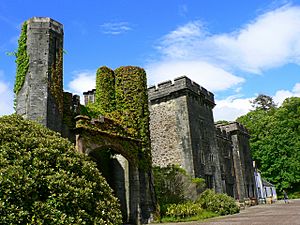
His eldest son, Alexander Wentworth Macdonald, became the 2nd Baron Macdonald. He lived mostly in England and didn't have much contact with his tenants. He built the main house at Armadale in Sleat. He died in 1824 without children.
His brother, Godfrey Bosville – Macdonald, became the 3rd Baron. He had served in the British Army. He was also involved in a disagreement over who was the true chief of Clan Donald. He died in 1832.
Under the 4th Baron, Godfrey William Wentworth Bosville – Macdonald, large parts of the clan's lands were sold off, including North Uist and Kilmuir (which included Duntulm Castle). He died in 1863.
The current chief is Sir Ian Godfrey Bosville Macdonald of Sleat, the 17th Baronet. The chief's family has lived at Thorpe Hall in Yorkshire, England, since the 1700s.
Forced Emigration and the Ship of the People
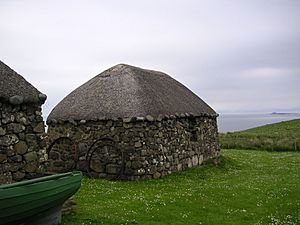
In 1739, the 1st Baron was involved in a sad event where people from Skye and Harris were forced onto a ship. The plan was to take them to the American Colonies and make them work as servants. This ship became known as Soitheach nan Daoine ("the Ship of the People").
The people on board were eventually rescued. Most settled in Ireland, but a few managed to return home to the Hebrides.
Later, the 4th Baron oversaw some of the most well-known forced removals of Highlanders during the Highland Clearances. For example, in 1849 and 1850, people were forced out of Sollas in North Uist. During the 1830s and 1840s, over 1,300 people were removed from their homes in North Uist to make way for sheep farms. Some people who protested were arrested.
Clan Profile
- Clan Chief: The current chief is Sir Ian Godfrey Bosville Macdonald of Sleat. He is the 17th Baronet of Sleat and the 25th chief of Clan Macdonald of Sleat. His Gaelic title is Mac Ùisdein ("son of Ùisdean").
- Chief's Coat of Arms: The chief's coat of arms shows a red lion, an armored hand holding a cross, a ship with furled sails, and a salmon. The crest is an armored forearm holding a cross.
- Motto: The clan motto is Per mare per terras, which means "by sea and by land" in Latin.
- Slogan: The chief's slogan is carna, named after a small island on Loch Sunart.
- Clan Member's Badge: Clan members can wear a badge with the chief's crest (an armored hand holding a cross) and the motto per mare per terras.
- Clan Plant Badge: The plant badge for the clan is common heath.
- Surname Origin: The name Macdonald comes from the Gaelic Mac Dhomhnuill, meaning "son of Domhnall." The name Domhnall means "world might" or "rule."
- Pipe Music: There are pipe tunes linked to the clan, like Cumha na Coise and Sir James Macdonald of the Isle's Salute.
Images for kids


